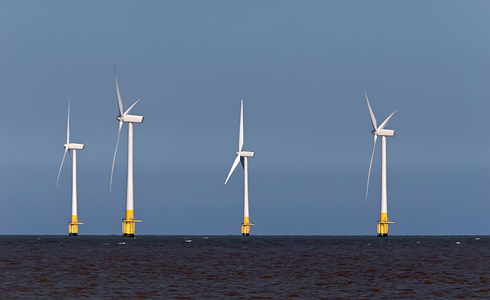As a result, Allianz is already involved as an insurer in over 30 offshore wind projects. More expansion is planned in this critical business area – despite the many challenges. The experts Dr. Wolfram Pazur from Allianz Germany and Robert Maurer from AGCS discuss risks and opportunities for insuring this sector.
"Doing our part as an insurer to protect the climate"
Allianz currently does not invest in offshore wind, but it does insure it. Why does Allianz provide insurance cover?
Robert Maurer (AGCS): Billions of euros are being invested in offshore wind farms. That comes with considerable risks for investors and operators. Allianz helps these projects become reality with specially designed insurance solutions. In this way, we support our long-time clients like energy providers and turbine producers but are also interested in getting new customers and taking part in this growing market.
Wolfram Pazur (Allianz Deutschland): Insuring wind farms at sea is our way of contributing to climate protection. That's because renewable energies are today's innovative segment for tomorrow. However, that and the change in energy policy will hardly be possible without offshore wind energy. Wind at sea and the energy to be harvested from it are enormous. As an engineering insurer we want to support our customers with the right insurance cover.
Does insuring offshore wind farms present unique challenges compared to onshore wind?
Wolfram Pazur (Allianz Deutschland): Yes, quite a few in fact. Just the sheer size of the individual windmills makes offshore wind farms extremely challenging. Parts have to be brought out to the assembly site with special ships. At depths of up to 40 meters, the foundations need to be especially strong. On top of that, the whole structure needs to be designed to withstand natural hazards like giant waves and corrosive seawater. The maritime environment is a real issue for operators and insurers. No one can say how the interaction of wind, waves and currents will affect the foundation. The cable connections can be very critical because if they fail, the supply of electricity to the mainland will break down. And who carries that risk? In Germany right now there's a gap in the law with the result that this risk lies with the insurer.


Allianz is already involved as an insurer in over 30 offshore wind projects. More expansion is planned in this critical business area – despite the many challenges.
Where are the largest potential losses?
Maurer: The major risk is damage to the sea cable, especially if that shuts down several wind farms at once. These kinds of damages often happen even during construction. A cable that's been laid on the seabed could be hit by the anchor of a construction ship, or a ship could ram one of the pilings of a windmill. During operation that could happen as a result of normal shipping traffic. If the sea cable were to get damaged in November, you're looking at a huge business interruption loss. That's because it's the start of the stormy winter period with high swells. In the worst case, repairs would have to wait until spring or could only be done with very expensive special vessels.
How can you even determine risks without any historical data?
Maurer: Indeed, it is difficult to calculate premiums. The risks are complex and new, and there are no historical loss tables. What helps is experience with onshore parks and simulating the weather risks. Also, our risks consultants evaluate equipment and logistics. With time we will be able to compare our expectations with actual losses and that way we will be able to continuously improve our risk assessment and calculation.
Are the risks different in different countries?
Pazur: In Germany we face special risks, in particular because the Wadden Sea on the German coast is a natural preserve. For that reason wind farms are farther off at sea than, say, the British coast. Also, they aren't allowed to block the view from land. That means unique challenges for insurers. Ships have to travel six hours before they even get to the construction site. A lot can happen in this time, like a change in weather.
Maurer: Internationally the standards for logistics and technology really are very diverse. So you see individual turbine makers employing different concepts and quality management. In Great Britain, Denmark and Belgium the wind farms are only 10 to 20 kilometers off the coast, which makes construction, later maintenance and the cable connections much easier. As an insurer we would like to see international standards for building and operating wind farms. That's why we are collaborating on establishing a Joint Code of Practice for such matters.
So despite these risks in offshore wind it's "full speed ahead" for Allianz?
Maurer: The shift in energy generation is a political and social project – and as an insurer we are glad to do our part. In that regard, offshore wind energy has a special place in the growth market for renewables. It is the only regenerative energy source that is able to replace conventional power plants. However, the entire industry is still at the beginning of a learning curve. That is why we are closely observing offshore wind risks and carefully examining each case individually. It is only in the next few years that we will learn more about the robustness and the costs for the operation and maintenance of wind farms at sea.
Pazur: By 2030, German coastal waters alone will generate 25,000 megawatts of electricity; more than 90 wind farms are planned for the North Sea and Baltic Sea. This will require significant insurance capacity during the construction phase and then even more so during the operation phase. We see major potential for the sector and want to gain more experience during the assembly phase of offshore wind farms – both as a lead insurer but also as a co-insurer working together with others.

As with all content published on this site, these statements are subject to our Forward Looking Statement disclaimer.
Link to the disclaimer